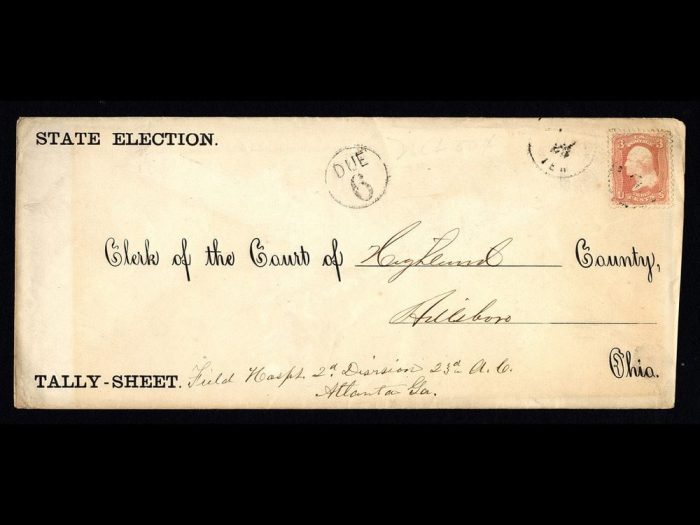How the Civil War Spawned the Mail-In Ballot
At the National Postal Museum, a new exhibition traces the long history of a newly popular way of voting

Not just for national elections, absentee ballots were also used by the states during the Civil War. Ohio issued this 1864 envelope for mailing in a tally sheet. National Postal Museum, SI
During the presidential election of 1992—when Bill Clinton ran against incumbent George H.W. Bush—I took my youngest daughter, Sarah, with me to the polling station. She was just 5 years old, and she quickly disappeared into someone else’s booth. When I asked her what she was doing in there, she answered: “I was making sure they voted correctly.”
Sarah is all grown up now—old enough to vote herself and respect voting privacy laws—but anyone who knows her would recognize that same conviction.
Despite our best attempts at privacy at polling sites, perhaps the only way to make sure there are no precocious little guests popping into your voting booth is to cast a mail-in ballot. However, privacy is not the only reason to consider this option.
During our last presidential election, Covid-19’s spread prompted an enormous increase in absentee voting nationwide: Nearly half of all ballots were mailed in. The unprecedented demand for voting by mail heightened public scrutiny of the practice, which was far from new. This election year, an exhibition at the National Postal Museum spotlights absentee voting and how it has evolved, from a wartime necessity to a protected right for many civilian voters.
During the Civil War, the future of the country was at stake, and a significant portion of eligible voters (white men 21 years old and older) had taken up arms. Most could not return to their home states to cast their ballots. The 1864 presidential election was the first time absentee voting was exercised at scale: Approximately 7.5 percent of the total vote was cast from the field or by proxy.
When American military personnel were deployed across Europe, the Pacific and the United States in World War II, official war ballots were shipped around the globe and back. Included in the museum’s collection is a 1944 ballot from an Army nurse; many of the women serving had gained the right to vote within their lifetimes.
The exhibition also details the efforts of Japanese Americans in internment camps in the 1940s to mail their ballots back to the cities and towns they had been expelled from. Each state and locality—for both the communities of origin and the location of the camp—had their own set of election laws to disentangle, but some incarcerated citizens were able to participate in a civic process that was failing them.
In tracing this history, I was struck by both the sanctity of the right to vote and the immense legal and logistical efforts behind every ballot. This exhibition tells a larger story of the U.S. Postal Service, an essential tool of American democracy—and it includes information on how to cast your ballot from anywhere in the world this November.
This post was originally published by the Smithsonian magazine blog, Smithsonian Voices. Copyright 2024 Smithsonian Institution. Reprinted with permission from Smithsonian Enterprises. All rights reserved. Reproduction in any medium is strictly prohibited without permission from Smithsonian Institution.
Posted: 4 September 2024
- Categories:



